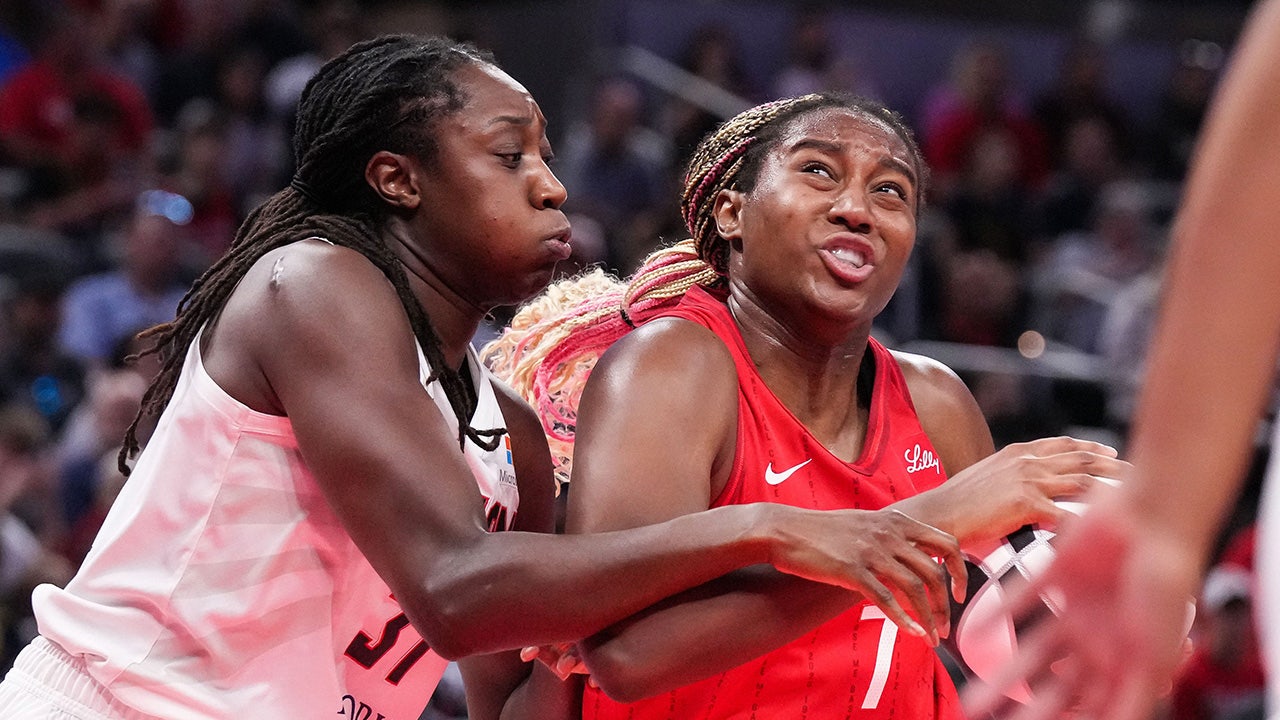The 10-second 100-meter dash. The four-minute mile. The two-hour marathon. In baseball, is the 110 mph fastball the next big number to fall? What actually is the upper limit when it comes to professional pitchers throwing their fastest pitches?
There is some debate about what the fastest fastball to date has been. In the documentary Fastball, filmmakers looked at a few key moments from the past. Bob Feller threw a ball faster than an 86 mph motorcycle. Nolan Ryan was clocked at 100.8 mph by a radar gun in 1974. If you convert Ryan’s number to the out-of-the-hand methodology used to measure pitch speed today, you get 108 mph. For some, that counts as the fastest pitch on record.
We’ve been tracking major-league pitchers with the same quality of technology since 2007, though, and nobody has thrown harder than Aroldis Chapman and his 105.8 mph fastball in 2010. So Ryan’s 108 would be a large departure from 15 years of tracking pitches — and, for what it’s worth, it’s a large departure from radar gun readings over the rest of his game that day, as well as the rest of his career, which usually topped out around 96 and 97 mph.
Some Nolan Ryan gun readings to show how random Radar gun/Laser technology was back in the day. pic.twitter.com/BAuEMAbTIM
— Rob Friedman (@PitchingNinja) January 20, 2024
Since those other pitchers were clocked using outdated technology, it’s probably fairest to call 105.8 mph the modern record in fastball velocity. So that’s how fast a human has thrown the ball. But what’s the fastest a human being could throw the ball?
“When you build up a simple physics model that is essentially a series of collisions between body parts, you get a max fastball velocity of about 125 mph,” said Jimmy Buffi, who has a PhD in biomedical engineering. Buffi is a former Los Angeles Dodgers analyst and is a co-founder of Reboot Motion, a player development consultancy firm.
“We’ll need to use new methods,” said Kyle Boddy, current Boston Red Sox consultant and the founder of Driveline Baseball, a player development lab and consultancy company. “If there is a way to continue on, it won’t be with current methods. Using the best mechanics from elite pitchers, piecemeal, is unlikely to be the way we can create the 110 mph pitcher.”
Others thought about the potential for injury in this pursuit – pitching injuries have been up with velocity, after all. Maybe we’re already at the limit?
“I don’t think people are going to be able to throw that hard,” said the Dodgers’ Bobby Miller, the league’s third-hardest throwing starter, about numbers like 110 and 125 mph. “You reach a certain point where your arm will probably break.”
That’s three different answers. Let’s take a closer look at each.
The case for 125 mph
There’s a concept in pitching called the “kinetic chain,” which describes the transfer of force from the ground, and the larger muscles in the legs, up through the core and out to the end of the arm. If you work in a purely theoretical space, that chain is basically a bunch of interactions that attempt to conserve the momentum created down low as it travels out to the arm. Buffi’s job at ReBoot is to help make those transfers as efficient as possible. He created a physics model to describe them for the purposes of answering this question.
“To come up with this toy example,” he said, “I thought of the pitching motion as essentially a series of energy transfers between two masses, similar to a large ball colliding with a smaller ball. The legs are the larger mass, and they transfer energy to the torso, which transfers energy to the upper arm, then to the forearm, then to the hand, then to the ball.”

A pitcher’s kinetic chain consists of six phases. (Graphic: Drew Jordan / The Athletic; photo of Paul Skenes: Rick Osentoski / Getty Images)
The relative sizes of each of those muscle groups govern the amount of energy that can be transferred in each interaction, just as it is in the classic physics problem in which a big ball hits a smaller ball. In the model that Buffi created, a 200-pound person putting 500 pounds of force into the ground while being 85 percent efficient in his transfers (an efficiency that is elite, but within the range of possibility, in his estimation) would throw 125 mph.
“Even though it’s a toy example, when you put in reasonable energy transfer numbers and ground reaction force values, you actually get reasonable pitching velocity estimates,” said Buffi.
One of today’s hardest throwers, Oakland closer Mason Miller, agrees that the size of the player and force into the ground was a common denominator when you look at the hardest throwers.
“Physically, I’m 230 pounds, maybe 240 at my biggest. Chapman is like 250 pounds,” said Miller. He has thrown the fourth-fastest pitch this season at 103.7 mph, which trails only a couple Chapman fastballs (one at 104) and one from Angels reliever Ben Joyce. “Force production into the ground is important, we’ve seen that from force plate testing, that’s a good measure of power production.”
But there are some flaws in this case. Ground force reactions north of the ones Buffi used have been recorded already by athletes at Driveline Baseball, and they didn’t throw 125 mph. It’s way out in front of what’s been observed, as well.
Said Miller: “125 seems like it’s way out of our current existence.”
“Oh my goodness, 125, that’s crazy,” said Twins’ closer Jhoan Duran, who has topped out at 104.8 mph.
The case for 110 mph
The study of biomechanics, or the mechanical laws relating to the movement and structure of living organisms, has unlocked velocity for a lot of today’s hard throwers. The average four-seam major league fastball, measured by the same technology and methodology, has increased in velocity every season since Major League Baseball started tracking it, all the way from 91.1 mph in 2007 to 94.1 now.
Sam Hellinger of Driveline Baseball shared an example of how this understanding of the body has helped players train to get more velocity. Justin Thorsteinson, a former Division I pitcher hoping to sign on with an organization, came to them throwing 87.7 mph in June and by August was throwing 91.5 mph, and his changing how his shoulder moved was key. Scapular retraction — in rudimentary terms, how far back the throwing shoulder reaches before coming forward — has been linked to velocity by biomechanics studies because it creates a big separation between the hip and the shoulder. As that separation snaps back like a rubber band, torso speed is accelerated, which is then transferred to the arm. That was a big focus for Thorsteinson.
“Based on Justin’s bio report, we determined that his most glaring need mechanically was his arm action, specifically his max shoulder external rotation and scapular retraction,” said Hellinger.
After some work with weighted balls and specific drills, Thorsteinson improved his scores in the specific biomechanics that they were targeting, as you can see also from this picture, which shows how much he improved his shoulder retraction.

Before (left) and after (right) for Justin Thorsteinson, showing more shoulder retraction after the drills. (Driveline Baseball)
So could a 250-pound monster of an athlete refine each of his movements to the best of current knowledge and bust past the 106 mph ceiling towards the 110 mph that Boddy thought possible?
“If you’re getting bigger than Chapman, who throws 105, if you get any bigger, you lose coordination,” said Dodgers starter Walker Buehler. “He’s as big and as strong as you can be, and his delivery is all about velo.”
Boddy is also not sure that a big dude, plus the best piecemeal mechanics of our time, was the right way forward.
“We’ll need to use new methods, like simulation of human movement with millions of synthetic data points using machine learning and artificial intelligence to explore the entire latent space of possible mechanical outputs and muscular contributions to the throwing motion,” said Boddy. “This is something Driveline Baseball has been working on for years and is rapidly becoming a priority project — primarily for durability improvements over performance gains, though we anticipate breakthroughs in both realms over the coming years from our Sports Science and Research teams.”
In other words, instead of taking our mythical 250-pound flamethrower and then giving him what modern research thinks is the best mechanics in the legs, the torso, the shoulder, and the arms, Boddy is hoping that AI could help us think of new ways those body parts could move in concert with each other, in order to identify even better possible mechanics.
Could AI do this? Given the rapid rise of that technology, it seems plausible that we could see gains from re-evaluating current processes, even ones that involve the movement of our bodies.
The case for 106 mph
Let’s flip over to a different sport for a second. Over in the 100-meter dash, we have records going back to the 1970s. If we track the best times by year, it looks like we’re hitting a bit of an asymptote — instead of large gains like we saw in the 1980s and ’90s, we’re fighting over smaller increments of change.
If you altitude-adjust these numbers — running higher up can shave some milliseconds, as we saw with a couple of record-breaking runs earlier this century — we’re zeroing in around 9.7 to 9.8 seconds as perhaps the fastest a runner can manage in a neutral setting. This is seen by some to show that modern training, nutrition, and equipment have pushed the body as far as it can go. There are similar graphs in other running sports that suggest the same.
A few examples from other sports:
100m sprint, marathon & 1 mile world record progressions pic.twitter.com/6z5nhPPbdP
— Ben Brewster (@TreadAthletics) May 28, 2024
The maximum pitch velocity seems to be following a similar trajectory in baseball. Chapman threw 105.8 mph in 2010 and since then, the average best fastball has been 104, with a peak of 105.7 (Chapman again in 2016) and a nadir of 102.2 (in 2020, of course). The best non-Chapman fastball is around 104 mph in any given season.
There are some differences between pitching and running, though. Here’s where Glenn Fleisig, the director of biomechanics research at the American Sports Medicine Institute, comes in.
“Fifteen years ago I was quoted as saying that I didn’t think top velocity or the ceiling going up, but I foresee it getting pretty crowded at the ceiling,” said Fleisig. “It wasn’t a lucky guess that I pulled out of my butt.”
“When others talk about the ceiling, they talk about physics and statistics. Maybe by the laws of physics, maybe people could throw faster. Maybe the highest number could keep going up like it (did) for runners, because the training can improve, the mechanics and biomechanics can improve, the nutrition and supplements can improve,” he continued.
“The difference here is that we’re pushing this little ulnar collateral ligament to its limit. We are strengthening our muscles and improving our mechanics and nutrition, but based on how the body is built, the ligaments and tendons don’t improve proportionally to the other parts of the body and the process.”
When that ligament tears, the pitcher needs Tommy John surgery to get back on the mound, and those surgeries are more common than ever. How much stress that ligament can handle might be up for debate.
“No one really knows how much stress a UCL can really take, because of a problem I call cadavers and robots,” said Randy Sullivan of the Florida Baseball ARMory on a recent podcast. “We determined how much stress a UCL can take through a cadaver setting where we found that it tears at 35 newton-meters of torque, and then we used motion capture to determine that it can tolerate on a single pitch, it has to accept 70-75 nM of stress. We got the bottom number from a person who wasn’t alive; living tissue wouldn’t react the same way. And we got the top number from a model, a mythical robot.”
Fleisig, who authored the study that looked at how much stress the UCL could handle in cadavers, saw that second number in a slightly different light.

Throwing high-velocity pitches puts a great deal of stress on a pitcher’s UCL. (Drew Jordan / The Athletic)
“That 70-75 nM dynamic stress from biomechanics analysis is on the entire elbow, and the UCL does about a third of that resistance, your bones and tendons help with that resistance,” he points out. Taking a third of 75 nM leaves the current stress on the elbow within the 35 nM maximum we see in cadavers.
The sport might be telling us something with the spike in arm injuries. All those torn ligaments, which are increasingly tied to top-end velocity by the best available research, seem to suggest that we are running up on the physical limits of that little tendon. Maybe 106 is all that we can do.
“I’ve thought about it before,” said Joyce, the Los Angeles Angels pitcher who has thrown the hardest this year and also had a fastball tracked at 105.5 mph in college. “I would think someone will hit 106.0, but I don’t know if there is much more than that.”
Where do we go from here?
The work to improve the ceiling will go on, no matter what injuries say, because of the reward system in place for pitchers who can throw hard. The highest draft picks, the biggest free-agent contracts — those go to the fastest fastballs, and that’s not likely to change in the short term.
Joyce has an identical twin who tops out at 98 mph, with similar mechanics and identical genes. So what separated Ben from his brother Zach?
“I didn’t do anything specific,” said the harder-throwing Joyce. “I just always wanted to throw hard, so I tried to throw harder every day, kept throwing harder and harder, and it eventually worked out.”
Joyce pointed out that he hadn’t really optimized his mechanics or done anything special in that regard. He’s just throwing 103 and 104 on pure willpower. He’s also a little smaller than Miller and Chapman. Maybe the next kid is 50 pounds heavier, has that same iron will, ends up as a reliever where he can max out on fewer pitches, and also optimizes his biomechanics. That scenario seems likely to push the top-end velocity some … but how much higher if that little ligament is taking all it can handle already?
If that combination of inputs only pushes maximum velocity forward a tick or two, it might behoove young pitchers to consider other goals as they come up the ranks. In other words, if we get to a point where everyone throws harder than 94 mph in the big leagues, but nobody really throws harder than 106, maybe the best way to stick out in the future will be to demonstrate a pitch mix with varying velocities and movements, with good command. Maybe the success of softer-throwing pitchers such as the Royals’ Seth Lugo, who throws eight different pitches from two different arm slots, and the Phillies’ Ranger Suárez, who keeps the ball on the ground with great command, can provide new role models for young pitchers.
As the injuries mount in the search for velocity, chasing a maximum number that might not even be possible may not be the best plan for a young arm interested in making the most out of his talent.
— The Athletic’s Sam Blum contributed to this story.
(Top image: Dan Goldfarb / The Athletic; Photo of Paul Skenes: Justin K. Aller / Getty Images)






